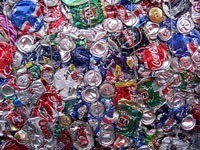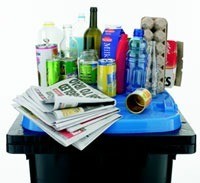
Recycling is slightly more complicated than just collecting a bin full of empty cans and old newspapers to keep them out of the waste stream. Many of us don't know what the rules are for recycling certain items. November 15 is America Recycles Day. Here is a basic guide to the most common household recyclables.
Aluminum: It's been reported that every three months, the U.S throws out enough aluminum to rebuild our entire commercial air fleet. That's too bad because aluminum is easy to recycle-including soda cans, beers cans and many pet food cans. Making new aluminum from old aluminum uses 95% less energy than making it from ore. Most community curbside recycling includes pick up of aluminum, and because recyclers are happy to pay for aluminum, collection sites are often created to raise money for school programs and sports teams.
Tin (or bi-metals): Soup and other canned foods are often made from bi-metals. Bi-metals are easy to spot, because unlike aluminum, they are magnetic. These cans are primarily recycled for their steel content. They cost more to recycle because of their mixed content, but more and more recycling centers are starting to accept them. Labels should be removed from these before recycling.

Scrap or Non-Ferrous Metal: Examples of scrap or non-ferrous metals include metal from things like old radiators, lawn mowers, car parts or piping. To recycle these items, look in the yellow pages under "scrap" or "metal recycling" or even "solid waste." It's a good idea to call ahead for information on what types of metals are accepted and what fees, if any, they charge.
Turning old glass into new glass takes up to 35% less energy than making it new. Glass recycling is a high-temperature process susceptible to contamination. Whole truckloads of glass can be rejected just because a few rocks, a small amount of dirt or even a few pieces of ceramics find their way into the mix and jeopardize the purity of the final product. For that reason, it's a good idea to remove any tops, lids or tampering seals before recycling, especially like those found on beverage containers.
Container Glass: All food and beverage containers are fine. It isn't necessary to remove the labels before recycling, but some centers may ask you to sort glass by color: clear, brown, green/blue. White and black colored glass is not recyclable, nor are mirrors, dishware, cookware or light bulbs. Broken glass is not recyclable either because it is hazardous to the workers who have to handle the materials during separation. Instead, they should be placed in a bag marked sharp objects and thrown in the trash.

Window Glass: Window glass is recycled using a different process than container glass. Most recycling centers don't accept it because the low amounts collected are not worth the cost of a run. Call a glass repair or installation professional for a recommendation on where to recycle window glass in your community.
Paper accounts for the greatest amount of solid waste in landfills around the country. "Recycled" paper can be misleading and mean anything from 100% of the paper is truly recycled to 1% of it is re-manufactured ends of large paper rolls. "Post-consumer" paper means that it comes from paper that has been recycled by consumers. For recycling purposes, the higher the percent of "post-consumer" paper the better. Recycled paper is categorized into grades:
High Grade: This paper includes both white and pastel office paper, envelopes (without plastic windows), computer printouts, lined notebook paper, stationary, index cards and post-it notes. It is highly recyclable and staples are usually ok.
Mixed Grade: Mixed grade paper includes glossy papers (magazines and catalogs) envelopes with windows, dark or fluorescent-colored papers, manila envelopes and tablet covers and Kraft (brown) paper. The paper must be clean, dry and free of food, wax, plastic and contamination. Pet food bags, fast food wrappers, milk and juice containers and thermal or laminated paper can not be recycled.
Low Grade: Newspapers, phone books and some black and white (non-glossy) catalogs are considered low-grade paper. Some phone books are made with glues that interfere with recycling, while others are not. Information about recycling your phone book should be printed on the cover.
Paperboard: Paperboard is used for dry good boxes like cereal and pasta or items like toilet paper and paper towels. Frozen food boxes should not be included in this group because they are often coated with wax and will contaminate the load.
Cardboard: Corrugated cardboard (ridges between the inner and outer layer) is highly recyclable. Many curbside collectors may ask you to cut cardboard to a specific size or bundle it together with string. Check to see if there are size or weight limits to your pick-up. If pick up is not offered in your area check with your local supermarket for drop off. Cardboard coated with wax, and wet or greasy cardboard (pizza boxes) cannot be recycled.
Many plastics are recyclable, but they are also made from fossil fuels, a non-renewable resource. For this reason it's even more important to keep them out of the waste stream as long as possible and then recycle them properly when they are no longer of use. For recycling purposes, plastics are coded according to material content with a number from 1-7. This is usually located on the bottom of the container inside the triangular recycling symbol. Even if a plastic is coded, it does not mean it can be recycled. Just like glass, the wrong plastic in a load will contaminate the whole "melt." Caps and lids are often not made of the same type of plastic as the original container and may be coded separately. If they are not coded (as is usually the case) they cannot be recycled.
Types 1 through 6 are all recycled into different products, although the degree they are accepted at recycling centers varies widely. Type 7 is generally not recyclable and should be avoided. Check with your local recycling center to see what types of plastics they accept.
About The Author: Ellen Brown is an environmental writer and photographer and the owner of Sustainable Media, an environmental media company that specializes in helping businesses and organizations promote eco-friendly products and services.
Add your voice! Click below to comment. ThriftyFun is powered by your wisdom!
I save any brass, copper, aluminum, stainless steel I find around. I keep it in one are in my basement. I'll save it for a year or two then take it to a scrap yard. Usually I'll get $20.-30.00 from things most people throw out.
Add your voice! Click below to comment. ThriftyFun is powered by your wisdom!